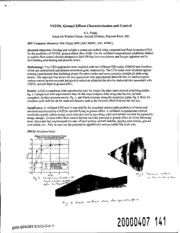
DTIC ADA375807: VSTOL Ground Effects Characterization and Control PDF
Preview DTIC ADA375807: VSTOL Ground Effects Characterization and Control
VSTOL Ground Effects Characterization and Control S.A. Polsky Naval Air Warfare Center, Aircraft Division, Patuxent River, MD HPC Computer Resource: SGI Origin 2000 [ASC MSRC, ARL MSRC] Research Objective: Develop and validate a numerical method using computational fluid dynamics (CFD) for the prediction of VSTOL ground effects flow fields. Use the validated computational prediction method to explore flow control devices designed to limit lift loss due to suckdown and hot gas ingestion and to limit landing area heating and acoustic levels. Methodology: Two CFD approaches were explored with two different CFD codes, USM3D and Overflow, which use unstructured and chimera-structured grids, respectively. The CFD codes were validated against existing experimental data including simple flat plate studies and more complex multiple jet delta wing studies. The approach that shows the best agreement with experimental data will then be used to explore various control device concepts designed to reduce or eliminate the adverse characteristics associated with VSTOL aircraft flight in ground effect. Results: Initial comparisons with experimental data for simple flat plate cases showed promising results, fig. 1. Comparison with experimental data for the more complex delta wing case has not yet been completed. Surface pressure results, fig. 2, and Mach contours along the symmetry plane, fig. 3, from the Overflow code indicate all the expected features such as the fountain effect between the two jets. Significance: A validated CFD tool is essential for the expedient and accurate prediction of forces and moments experienced by a VSTOL aircraft flying in ground effect. A validated computational method would also greatly reduce design cycle time and cost by providing a fast and reliable test bed for parametric design changes. Ground effect flow control devices have the potential to greatly affect all of the following areas: thrust and fuel requirements for take off and landing, aircraft stability, landing area erosion, ground crew safety, etc.. This, in turn, has the potential to significantly reduce overall life cycle cost. JWCO: Precision Force Effects of Ground Proximity on Thrust NACA TN 4407 Compared to CFD RMtAs Ooo~ ^"~, ^ ^—^1 P^C Fv 3 fvx^ck co' t 20000407 HI p.jlC QUALITY DfGEECTSD 1 REPORT DOCUMENTATION PAGE Form Approved OMB No. 0704-0188 Public reporting burden for this collection of information is estimated to average 1 hour per response, including the time for reviewing instructions, searching existing data sources, gathering and maintaining the data needed, and completing and reviewing this collection of information. Send comments regarding this burden estimate or any other aspect of this collection of information, including suggestions for reducing this burden, to Department of Defense, Washington Headquarters Services, Directorate for Information Operations and Reports (0704-0188), 1215 Jefferson Davis Highway, Suite 1204, Arlington, VA 22202-4302. Respondents should be aware that notwithstanding any other provision of law, no person shall be subject to any penalty for failing to comply with a collection of information if it does not display a currently valid OMB control number. PLEASE DO NOT RETURN YOUR FORM TO THE ABOVE ADDRESS 1. REPORT DATE 2. REPORT TYPE 3. DATES COVERED Professional Paper 4. TITLE AND SUBTITLE 5a. CONTRACT NUMBER 5b. GRANT NUMBER VSTOL Ground Effects Characterization and Control 5c. PROGRAM ELEMENT NUMBER 6. AUTHOR(S) 5d. PROJECT NUMBER Susan A. Polsky 5e. TASK NUMBER 5f. WORK UNIT NUMBER 7. PERFORMING ORGANIZATION NAME(S) AND ADDRESS(ES) 8. PERFORMING ORGANIZATION REPORT NUMBER Naval Air Warfare Center Aircraft Division 22347 Cedar Point Road, Unit #6 Patuxent River, Maryland 20670-1161 9. SPONSORING/MONITORING AGENCY NAME(S) AND 10. SPONSOR/MONITOR'S ACRONYM(S) ADDRESS(ES) 11. SPONSOR/MONITOR'S REPORT NUMBER(S) Naval Air Systems Command 47123 Buse Road Unit IPT Patuxent River, Maryland 20670-1547 12. DISTRIBUTION/AVAILABILITY STATEMENT Approved for public release; distribution is unlimited. 13. SUPPLEMENTARY NOTES 14. ABSTRACT Develop and validate a numerical method using computational fluid dynamics (CFD) for the prediction of VSTOL ground effects flow fields. Use the validated computational prediction method to explore flow control devices designed to limit lift loss due to suckdown and hot gas ingestion and to limit landing area heating and acoustic level. 15. SUBJECT TERMS 16. SECURITY CLASSIFICATION OF: 17. LIMITATION 18. NUMBER 19a. NAME OF RESPONSIBLE PERSON OF ABSTRACT OFPAGES Susan Polsky a. REPORT b. ABSTRACT c. THIS PAGE 19b. TELEPHONE NUMBER (include area code) Unclassified Unclassified Unclassified Unclassified (301) 342-8575 Standard Form 298 (Rev. 8-98) Prescribed by ANSI Std. Z39-18
